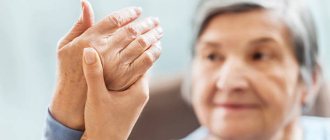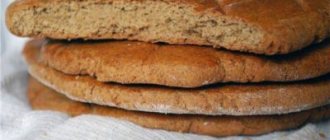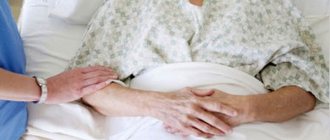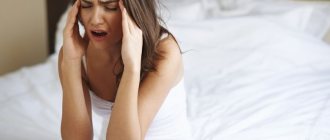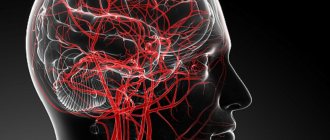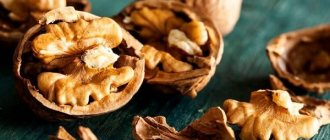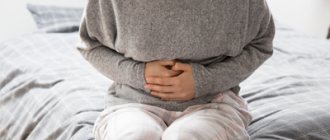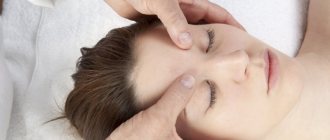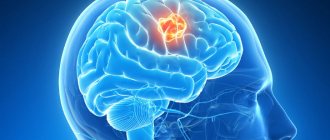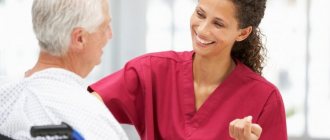Help and first actions of medical workers
Stroke is divided into two types:
- Hemorrhagic is a rupture of cerebral vessels, as a result of which blood begins to accumulate in the tissues, blood clots put pressure on the nerve endings, disrupting their functioning.
- The most common type is ischemic stroke, which is characterized by blockage of blood vessels in the brain, and the obstruction stops normal blood supply. Nutrients do not reach the nerve cells, which leads to the destruction of nerve endings.
Folk remedies for stroke can be very effective at the first signs of an impending illness. So, the first symptoms of a pre-stroke condition are:
- severe weakness in the lower or upper extremities (usually in the lower);
- confusion of thoughts, inability to formulate the simplest phrase, slurred speech;
- visual impairment;
- severe headache, migraine;
- frequent dizziness;
- ringing in the ears, feeling of a stuffy ear;
- violation of the sense of time and space;
- memory impairment.
All of the above symptoms of a stroke appear due to the fact that the brain no longer receives enough oxygen and nutrients. Immediate treatment can effectively cope with the serious consequences of a stroke suffered by a patient. Traditional methods of treatment have restorative effects and will help you overcome the disease faster and without serious complications.
In the first minutes after arriving at the location of a person suffering from a stroke, the ambulance team specialists assess the severity of the patient’s condition. Their main task is to transport the patient to a hospital equipped with an intensive care unit.
During transportation the following is carried out:
- Blood pressure measurements;
- Administration of drugs that correct the functioning of the cardiac and respiratory systems.
We do not transport patients who:
- They were found in a coma;
- If they have circulatory disorders in the brain in terminal conditions of various pathologies of internal organs or tumors.
Patients with such deviations are provided with symptomatic care, after which the call is transferred to the clinic.
Causes of stroke
There is no single reason for the development of stroke. Rather, we can talk about risk factors that can trigger the development of the disease.
These include some pathological conditions of the body:
- CVD diseases;
- high blood pressure;
- atrial fibrillation;
- the patient has a history of myocardial infarction;
- heart failure;
- pathologies in which the function of the carotid arteries supplying the brain is impaired;
- elderly age;
- diabetes;
- hereditary predisposition - if close relatives have had a stroke, this increases the likelihood of developing the disease;
- violation of fat metabolism.
In addition, the trigger the development of a stroke:
- bad habits (alcohol abuse, smoking);
- obesity;
- unhealthy diet with a predominance of fatty foods and a small amount of foods rich in plant fiber;
- constant stress;
- sedentary lifestyle;
- decrease in the amount of testosterone in the blood;
- uncontrolled use of oral contraceptives.
The provoking factors described above most often lead to the development of ischemic stroke. The development of hemorrhagic stroke can be provoked by:
- alcohol abuse;
- high blood pressure;
- taking various psychostimulants;
- blood clotting disorders, which may occur as a result of taking certain medications (thrombolytics, disaggregants, anticoagulants) or thrombus formation pathology;
- vascular diseases that are responsible for the blood supply to the brain.
Anti-blockade remedies
Treatment of nocturia in women with drugs and folk remedies
Cerebroprotective activity has been recorded in 200 varieties of plants, which have a similar effect as many analgesics and vascular drugs.
The use of herbs in cases of impaired blood supply to the brain is due to their therapeutic effect:
- Rhodiola, pomegranate – protect nerve cells from destruction;
- garlic, Dioscorea Caucasica, arnica – cleanse vascular channels of cholesterol deposits;
- Leuzea rhizomes, sage - eliminate problems with memory and speech;
- blueberries, rowan - tone arterial walls;
- astragalus, eucommia - lower blood pressure.
Herbal treatment for stroke is not a full-fledged therapy, but it helps clear vascular channels, improve blood flow to the brain and increase the immune response. For these purposes, beekeeping products, beaver stream, plant fruits, conifer cones, decoctions and infusions of medicinal herbs are used.
The therapeutic effect appears with long-term systematic treatment. Alternative medicine should complement general therapy, so the use of herbal remedies should be agreed with a doctor.
The human body in the post-stroke phase can unexpectedly react to any plant. Therefore, taking natural medicines should begin with a tablespoon, this will allow the body to adapt and correctly perceive the remedy.
Pine cones
Cones are a unique gift from nature that accumulates a number of valuable compounds. Such medicinal elements include phytoncides, vitamins and tannins, which improve the resistance of brain cells to irritants. During the impact, neurons die due to disruption of tissue blood supply. Even after restoration of cerebral circulation, cells continue to be destroyed due to the action of a special enzyme. Elements present in the bud destroy this enzyme.
You can prepare a pine tincture for stroke or a decoction. To obtain a tincture after a stroke, pour 5 cones with a glass of alcohol and leave for 14 days. Take the medicine one teaspoon a day, adding the tincture to tea. To get a healing decoction, you need to boil 5 cones in half a liter of water. The solution is taken in quarter glasses three times a day.
Herbal collection
The use of herbs after a stroke helps restore lost functions. Plants cleanse arterial walls, lowering blood pressure. It is necessary to mix dried immortelle, St. John's wort, birch buds and chamomile. A tablespoon of the mixture is poured into 500 ml of boiling water and left for an hour. I take a glass of medicine a day before bed. To improve the taste, you can add natural honey.
Hawthorn
The plant is rich in beneficial compounds such as:
- quercetin – normalizes blood circulation in the brain, fights heart disease;
- quercitrin – increases vascular strength;
- hyperoside – enriches the blood with oxygen, improves myocardial contractility;
- Vitexin - dilates vascular channels.
You can prepare a decoction or tincture that will help prevent the blockade.
Citrus blend
At home, you can prepare a healthy mixture that promotes the evacuation of excess fluid and increases the body's defenses.
It is necessary to grind 2 oranges and 2 lemons in a meat grinder, add 2 tablespoons of natural honey to the pulp, mix. You need to take 2 teaspoons per day before meals. Therapeutic course is a month.
Lemon-cranberry mixture
This recipe for stroke cleanses the body of atherosclerotic formations, fatty deposits, is used in the treatment of atherosclerosis, stroke, heart attack, and restores vision.
To prepare the mixture, you need to chop 1 kg of cranberries, half a kilogram of lemons, and mix the ingredients with a liter of natural honey. The medicine is taken one tablespoon twice a day.
horse chestnut
The plant contains a high concentration of biologically active elements that strengthen arteries, fight inflammation in capillaries, and nourish brain structures.
These substances include flavonoids, escin, and ascorbic acid. To treat a stroke, you need to pour 500 ml of boiling water over 10 crushed fruits and leave for 7 days.
Pine tea
A folk remedy against stroke is stroke prevention. You can brew spruce or pine branches directly in the teapot. It is recommended to drink the tea drink as often as possible, adding a slice of lemon to it.
The infusion cleanses the vascular channels, normalizing blood pressure. The medicine can be used for 5 months.
Stroke prevention. Hemorrhagic and ischemic stroke. What to do after a stroke.
Treatment of hemorrhagic stroke at home with folk remedies
Hemorrhagic stroke - treatment with folk remedies
Stroke (from the Latin insulto - I attack, I attack) is an acute disorder of cerebral circulation that occurs suddenly. Occurs most often against the background of hypertension, atherosclerosis of cerebral vessels, as well as with aneurysms or other anomalies of cerebral vessels.
All strokes can be divided into 2 types - hemorrhagic (bleeding into the brain under the membranes) and ischemic (thrombosis of cerebral vessels, ischemic softening of cerebral vessels, etc.).
Hemorrhagic stroke
develops most often as a result of increased permeability of the vascular wall. Vasomotor disorders of the vascular wall are important here, which is facilitated by sharp increases and decreases in blood pressure. In the area of hemorrhage, a focus of red softening is formed and, in the final stage, a cyst and scar changes in brain tissue.
Hemorrhagic stroke
may also be the result of rupture of aneurysms of the vessels of the base of the brain.
A stroke usually occurs suddenly and can lead to death within the first hours. It occurs most often after suffering from unrest and stressful conditions, more often in the evening or during the day. Sometimes so-called precursors of a stroke may be observed in the form of headache, dizziness, heaviness in the head. When a stroke occurs, the following symptoms appear: the patient suddenly falls, loses consciousness, and develops a coma. Breathing is hoarse, loud, pulse is tense, blood pressure is often elevated. The face is purple or bluish-purple, and vomiting is common. An indifferent gaze, “floating” pendulum-like movements of the eyeballs, sometimes averting the eyes towards the lesion. Involuntary loss of urine and feces may occur.
On the side opposite to the lesion, paralysis of one or both limbs is detected, and facial asymmetry is revealed.
If you suspect a stroke, you should urgently call a doctor!
Home treatment of hemorrhagic stroke (i.e. first aid before the doctor arrives) is very important because it greatly reduces the time of stroke care.
Before the doctor arrives, the patient must be placed comfortably on the bed, his clothes unbuttoned, and a flow of fresh air allowed. To prevent the patient from suffocating during bouts of vomiting, tilt your face to one side and lift it up. Ice packs or heating pads should be placed on the occipital and parietal area, and if it is not available, at least wet towels. Place heating pads or mustard plasters at your feet.
An old proven remedy for healers and herbalists was to “throw blood” in cases of stroke. The veins in the arms or legs were punctured and the black blood drained. Bloodletting usually significantly improved the patient's condition.
If the patient is able to swallow. it is necessary to give him sedatives and blood pressure lowering agents (if the patient is hypertensive). It is not recommended to transport a patient to a hospital without a doctor’s opinion.
Healers have long recommended that in case of a stroke, as an emergency remedy, placing an ice pack on the head, and the bubble is placed on the side opposite the paralyzed side of the body.
After the patient comes to his senses, he should be given a laxative (Glauber's salt, herb or senna tablets) and an enema.
When the acute symptoms have passed, traditional medicine recommends the following for the treatment of hemorrhagic stroke at home:
* CINNAMON ROSE HIP (roots, fruits). Externally, a decoction of the roots is used for baths for paralysis and paresis. Baths are done every other day. The course of treatment is 20-30 baths. Water temperature 37-38°C.
* It is useful to rub any volatile ointment into paralyzed limbs several times a day (you can mix one part of alcohol with two parts of vegetable oil). Ether is often used for this purpose, but when using it, you must remember that ether is highly flammable.
* PEONY ESCAPE (roots). Grind 1 teaspoon of dry roots and pour a glass of boiling water. Leave in a warm place for 1 hour, strain. Take 1 tablespoon 4-5 times a day.
* ALCOHOL TINCTURE OF THE ROOT OF PEONY EVADIUS (1 teaspoon of dry crushed roots, pour 300 ml of vodka and leave in a warm place for 7 days). Strain. Take 25 drops three times a day.
* WHITE STEP (paralysis grass). Pour 1 tablespoon of crushed roots into 300 ml of vodka. Leave in a warm place for 7 days. Strain. Take 25 drops morning and evening with water after meals.
* Cut 2 medium-sized lemons and 2 oranges into pieces, remove the seeds and pass through a meat grinder. Mix the resulting mass with 2 tablespoons of honey. Keep in a glass jar for one day at room temperature, then put in the refrigerator. Take 1 tablespoon 2-3 times a day with tea.
* Brew 1 tablespoon of crushed celandine with 1 glass of boiling water for exactly 15 minutes. Strain, take 2 tablespoons 3 times a day before meals. The course of treatment is 2-3 weeks.
* Peel ½ lemon. chop, pour 1 cup of pine needles (pour 1 tablespoon of pine needles with a glass of boiling water, leave for 1 hour, strain) and take on an empty stomach (an hour before meals or an hour after meals for 2-3 months).
* SAGE works well for stroke patients. Combine ingestion of sage infusion (1 tablespoon per glass of boiling water, leave for 1 hour) with general sage baths (300 g per 10 liters of water). First, cold water is poured into the bath, then hot water, then a sage decoction is added.
* Coniferous baths have a beneficial effect on patients.
* The patient is given a medium-sized clove of garlic and a teaspoon of honey every morning and evening.
* Prepare Sprouted GRAIN SPROUTS for a stroke patient every day for breakfast. The method for preparing grain sprouts is given in the chapter “Treatment of atherosclerosis.”
* LAY OIL. Pour 30 g of bay leaf into a glass of vegetable oil and leave, shaking daily, in a warm place for 2 months. Strain and bring to a boil. Rub daily into paralyzed areas.
* Make an ointment from powder: bay leaf - 6 parts, juniper needles (or fir, pine, spruce) - 1 part, butter - 12 parts. Rub into paralyzed areas 2 times a day.
* ALCOHOL TINCTURE OF CHILIBUCH OR Echinopsia (medical name “echinopsia”) helps to cure paralysis. 1 tablespoon of herb is poured with 0.5 liters of vodka and placed in a warm place for 21 days. Strain. Drink 30 drops three times a day.
* BLACK ELDERBERRIES are drunk with tea or instead of tea.
* GREEN TEA. Properly brewed green tea has a good effect on stroke patients. Monitor your blood pressure when drinking green tea!
* TANNISH SUMACH (dyeing sumac). Fresh leaves are used to treat stroke. 1 teaspoon of them is brewed with a glass of boiling water. Insist, wrapped. 1 hour, strain. Take 1 tablespoon 3-4 times a day.
* Mix 100 g of chamomile flowers, St. John's wort, caraway seeds and birch buds. Pour 1 tablespoon of the mixture with a glass of boiling water, add another 300 ml of water, bring to a boil. Drink warm with 1 teaspoon of honey, 1 glass in the morning 20 minutes before meals and in the evening at 21:00. After taking the medicine, do not eat or drink anything. Drink daily until the mixture runs out. Repeat treatment after six months and after a year.
* Take any heart mixture (can be bought at a pharmacy), add to it 4 types of cereals: oats, soybeans, buckwheat, millet (or any others). Then add the following herbs: string, celandine, plantain, burdock root, chaga, yellow immortelle (add 100 g of cereals, 2 tablespoons each). All this is passed through a meat grinder and placed in a common container. Mix thoroughly. Pack the resulting mixture into half-liter bottles so that they are 1/3 full, and fill the remaining 2/3 with sunflower or olive oil. Place in a warm place for 2 months. Shake well every day to prevent sediment from forming. After 2 months, pour everything into one container and heat to a temperature of 60°C. Don't boil! After heating, pour into bottles again and place in a warm place for another 1 month (shake daily). Three months after the start of preparation, the medicine is ready. Rub it into paralyzed limbs every other day. Leave the medicine on the body overnight. After 20 days of treatment, take a 10-day break, then do another 10 rubs. Then again a break of 10 days.
In the same way, carry out the 2nd and 3rd cycles of treatment after a month of break. Take a break for six months and carry out 2 more courses of treatment in the same order.
After a stroke, the patient needs to be careful. Mental fatigue should not be allowed. Alcohol, coffee, tea should be completely excluded from the patient's diet. If possible, reduce your consumption of oil, meat and sugar.
We should never forget about physical procedures (available to the patient) and sports.
Restoring everyday skills
Treatment of cerebral atherosclerosis with folk remedies
After a stroke, many patients lose basic skills - they cannot eat or undress. A number of exercises will help you regain lost functions:
- Food. The assistant directs the movements of the affected hand to take food from the plate and bring it to the mouth.
- Opening the tap. It is better to sit the patient on a chair. An assistant guides the paralyzed or weakened arm to start the water. In this case, the healthy one is used to check the temperature.
- Washing. The assistant moves the paralyzed hand to the healthy one, helps to take a sponge and wet it.
- Combing. The patient sits, tries to take a comb and comb his hair. It is advisable to make some movements with the affected hand. A second person helps him maintain his balance.
- Putting on a blouse, T-shirt. The victim sits, slightly bent, puts his clothes on his knees, presses his paralyzed arm between his legs, and places his sleeve there. An assistant helps put the injured arm into the sleeve up to the elbow, then puts the healthy arm into the second sleeve and puts the T-shirt on the body.
Recovery after a stroke
It's not called a brain stroke for nothing. For people who have had a stroke, their lifestyle changes dramatically. Muscles are paralyzed, stroke survivors are bedridden. How can they recover from a stroke at home using folk remedies and stroke recovery exercises? Cerebral hemorrhage is usually caused by high blood pressure and atherosclerosis of cerebral vessels, which impair the flow of blood to the brain. When the wall of a blood vessel ruptures, a hemorrhagic stroke occurs; when a vessel is blocked by an atherosclerotic plaque or thrombus, an ischemic stroke occurs.
The patient cannot do without an active course of rehabilitation and recovery after a stroke, no matter what the most modern methods are used in the hospital. Recovering from a stroke will require patience, perseverance, self-confidence, and the help of loved ones.
There is no need to think that after a stroke the disease will never return to you. According to statistics, it occurs again within six months in 10-20 percent of stroke survivors. Be sure to monitor your blood pressure readings (morning and evening) and take medications as prescribed by your doctor while still in the hospital. Folk remedies for hypertension will help reduce blood pressure in hypertension.
Patients who have had a hemorrhagic stroke should use blood pressure-lowering medications (hypotensives) after discharge. These include calcium channel blockers (Corinfar, Isoptin, Cardizem, Adalat), beta-blockers (atenolol, vasocardin), inhibitors (Enap, Renitek, Capoten), diuretics (hypothiazide, Triampur); (hypertension: treatment).
Statins (fluvastatin, atorvastin, simvastatin, lovastin), which lower cholesterol levels in the blood, are also usually prescribed for recovery after a stroke. Blood flow in the vessels of the brain is improved by pentoxifylline, nicoshpan, trental, xanthinol nicotinate. Patients who have suffered an ischemic stroke need to take small doses of dipyridamole or aspirin (acetylsalicylic acid) to normalize their blood composition. Antioxidants (beta-carotene, vitamins E, C) and antihypertensive drugs (ticlid, warfarin) will also help. Show character by quitting smoking, and remembering that it leads to blood clots in the vessels and arteries of the brain. Traditional medicine advice will help you quit smoking - how to quit smoking using folk remedies.
Exercises for recovery after a stroke
Typically, a person who has had a stroke cannot move. Don't be afraid. Restoring the movement of legs and arms after a stroke at home with exercises will take 2-3 months, even for those whom doctors have diagnosed with hemiplegia (the limbs are completely immobilized after a stroke). You need to start with a gentle muscle massage (stroking). Light rubbing will help well, increasing blood flow in paralyzed joints. Limbs need to be massaged 3-4 times a day for 10 minutes.
After 2 weeks, you can move on to more vigorous therapeutic exercises for recovery from a stroke. For 10-20 minutes 3 times a day, the patient needs to make circular movements, extension-flexion, lowering-raising of the elbow, hip, shoulder, ankle, knee joints. Increase the load every day. In each joint, the number of movements should first be 5-10, then (depending on how you feel) -15-20.
The following exercise for recovery after a stroke is performed with the help of a caregiver or family. Place the patient in such a way that the paralyzed muscles are stretched. Place a chair with a pillow next to the bed, and place the paralyzed arm on it, palm up. Straighten your arm at the elbow and move it to the side at a right angle. Place a pad of cotton wool and gauze under your arms to prevent your arm from falling towards your body. Bandage the forearm, hand, fingers to a splint (any hard material, for example, plywood covered with gauze). Place a bag with a weight weighing 0.5 kilograms on your forearm and palm. Bend the paralyzed leg at an angle of 15-20 degrees at the knee joint and place the same cushion. Hold your foot at a right angle to your shin (you can use a wooden box covered with quilted padding for warmth as a support). The patient should be in this position for 1.5-2 hours a day.
When the patient can sit up, assist him as follows. Place pillows under your back and head. By adding new pillows, move the patient to a semi-upright position in 2-3 days. You can help him lower his legs as early as 4-5 days. To do this, place a pillow under your back, secure your sore arm with a scarf, and place a bench under your feet. Increase the time you sit with your legs down, depending on how you feel - daily from 10-15 minutes to 1-2 hours. Move your legs to imitate walking. Monitor your pulse - the acceleration should not exceed 10-20 beats per minute.
Those who learn to walk easier while sitting will learn to stand faster. Holding your hand or the headboard with your healthy hand, let your ward stand up, and you hold him by the waist and at the same time use your foot to fix the knee joint of the ward’s leg in an extended state. The patient should stand upright. At first, 1-3 minutes is enough, then increase the standing to half an hour.
Soon try to master transferring the weight of the body from foot to foot. You definitely need to hold on to a chair, armchair, headboard. In a sitting position, you can work out your fingers and hands with an expander, rings, and balls. A walker, mobile playpen, cane, and crutches will help you learn to walk after a stroke. Take small steps, but adding steps every day. Choose shoes with low heels and high lacing to prevent your ankle from twisting (boots are better).
Once you have regained your walking skills, you should not relax. Like anyone else who has suffered a stroke, you need to continue strengthening your body. You should not forget in any way about daily exercise, jogging and walks in the parks, playing chess, reading, and doing crossword puzzles. Of course, flexibility of muscles and joints must be maintained. It is enough to do regular simple exercises to recover from a stroke.
You can effectively expand the range of motion and strengthen the muscles of the elbow joint, shoulder girdle, back, and hand using a regular pole or stick 1-1.5 meters long. Here are exercises for recovery after a stroke that are recommended to be performed repeatedly.
Exercise for recovery after a stroke with a pole parallel to the floor. With outstretched arms, slowly lift it to chest level. Stop for a moment and raise the pole to its maximum height. Bend your arms slightly at the elbow joints and place the pole on your shoulders, placing your hands behind your head. Again, raise the pole as high as possible and lower it slowly in front of you.
Exercise for recovery after a stroke with a pole vertically. Slowly, with outstretched arms, turn the pole clockwise, then counterclockwise.
Don't forget about fishing, swimming, skiing - in winter. Be patient, and your life will gradually return to normal.
Types of stroke
What ointments can be used to treat hemorrhoids during pregnancy? review of 12 safe drugs
There is an extensive classification of strokes according to location, volume of damaged parts of the brain, and the mechanism of development of the disease. There are the following types of this disease due to the causes of occurrence:
- Ischemic. It occurs most often and occurs due to blockage of a vessel, resulting in impaired blood circulation in a separate area of the brain.
- Hemorrhagic intracerebral. Occurs as a result of hemorrhage
- Subarachnoid hemorrhage due to vascular rupture
- Transient ischemic attack. This is a temporary blockage of a vessel, in some cases the patient does not realize that a mini-stroke has occurred
According to localization, the following types of disease occur:
- Extensive
- Lacunar
- Spinal
Symptoms of a stroke
The main clinical signs of the disease are:
- muscle weakness that occurs on the left or right side of the body (depending on which part of the brain is damaged);
- decreased sensitivity of the limbs;
- twitching on one side of the body;
- double vision and other visual disturbances;
- problems with speech and perception;
- Strong headache;
- problems with swallowing, drooling;
- tongue retraction, vomiting;
- facial asymmetry;
- sudden surges in pressure;
- fainting;
- dizziness, loss of coordination of movements;
- purple skin color;
- puffiness of the face;
- hearing loss;
- slowing and tension of the pulse;
- cold sweat;
- paralysis of limbs;
- frequent deep breathing, in some cases with wheezing.
If such symptoms appear, you must immediately call an ambulance and provide first aid to the patient. The patient should be placed on a flat surface, on his back, with a small cushion under his head.
The patient's outer clothing is removed, the windows in the room are opened to allow fresh air to flow in, a cold compress or ice is placed on the head, and mustard plasters are placed on the calves and soles.
It is advisable to monitor blood pressure and pulse and observe how a person breathes. When vomiting, care must be taken to ensure that the patient does not choke on the vomit. It is also important to ensure that your tongue does not sink.
Hydrogen peroxide for stroke
For stroke, treatment with folk remedies is carried out in different ways, one of which is the use of hydrogen peroxide. The product rarely causes adverse reactions and has almost no contraindications: the only situation when it is undesirable to use it is individual intolerance.
It is believed that timely injection of peroxide into the blood helps to avoid negative consequences. However, this method is not used in traditional medicine.
| According to experts, this remedy has virtually no contraindications. Its use is impossible only in case of individual intolerance. Hydrogen peroxide can be used to treat many diseases, including stroke. Its beneficial properties in this case are determined by its ability to regulate metabolic processes in the body. Intravenous hydrogen peroxide is not used in traditional medicine. However, based on the results of clinical studies, it was found that if you manage to get an injection in time for a stroke, you can avoid many serious consequences. Hydrogen peroxide solution is used as a mouth rinse. Regularly performing this procedure can prevent strokes. In addition, rinsing is not only the prevention of serious illness, but also a way to cleanse the mouth of food debris. You will need hydrogen peroxide with a concentration of 3%, which should be diluted in water. The ratio is 1:1. You can rinse your mouth with this solution for a minute. |
Diagnosis of stroke
The main methods for diagnosing the disease are:
- examination of the patient, assessment of his general condition;
- UZP test (checking whether a person can smile, speak or raise his hand);
- CT is the most informative diagnostic method for hemorrhagic stroke; with the help of this study, stroke can be clearly differentiated from other pathologies;
- MRI – suitable for diagnosing the ischemic form of the disease; with the help of MRI, it is possible to examine in detail areas of ischemia in the brain, assess the degree of their prevalence and the condition of neighboring areas of the brain;
- echoencephalography in combination with lumbar puncture - performed if it is impossible to do a CT or MRI;
- lumbar puncture - allows you to differentiate stroke from other brain diseases;
- ECG - identifies possible cardiovascular diseases that could trigger the development of a stroke;
- blood test (general, biochemical, sugar).
I follow the recommendations of the doctor - O.I. Shishova
Now my daily rule is what is written below...
—
namely:
Lymphatic self-massage
1. LYMPHATIC SELF-MASSAGE. For any feeling that the head is not right, that it is not thinking well, dizziness, headache, migraine... In the first stages, you need to do lymphatic self-massage to remove mechanical compression by the lymph nodes and the speed of blood flow to the brain.
It is necessary to activate the process of blood inflow and outflow into the brain using lymphatic self-massage, namely:
- — elimination of congestion in the left clavicular area
- — elimination of congestion in the right clavicular area
- - elimination of congestion in the left cervical area
- - elimination of congestion in the right cervical area
- - elimination of congestion in the cervical lymph nodes
- - elimination of congestion in the nasolabial lymph nodes
- - elimination of congestion in the occipital lymph nodes
- - eliminating congestion in the lymph nodes of the head
Diaphragmatic breathing
2. DIAPHRAGM BREATHING during the day, without raising your shoulders, on voluntary breathing, which allows you to PRACTICE eliminating congestion in the area of the abdominal aorta and vein and establish blood flow both in the head and in the upper and lower extremities. At the same time, remove the mechanical stagnation of bile in the duct. Until the duct opens in exactly this place, we will have a stagnant gallbladder, and this is already a gastrointestinal tract disease.
Any RETRACTION OF THE ABDOMEN causes a change in the state of blood circulation in the duodenum and bile is mechanically pushed out.
Bends forward before each meal helps to mechanically push the bile out of the duct into the duodenum. This promotes better digestion of food in the stomach and intestines.
Eliminating lymph stagnation
3. ELIMINATING LYMPH STAGNATION by raising your arms after eating for 3 - 5 minutes - what this gives: - a stomach full of food goes down and stops putting pressure on the heart and lungs. The lymph stops taking everything from the tank to the collarbone - stopping the outflow from the face... - the lymph leaves - the neck stretches - and the stomach stops putting pressure on the heart and lungs...
Rubbing the body before and during bathing
4. RUSHING THE BODY BEFORE BATHING AND DURING BATHING along the lymphatic lines and ducts, which allows us to - ACTIVATE THOUSANDS OF LYMPH NODES throughout the body. If the lymph node begins to be actively supplied with blood, it GIVES ACTIVE IMMUNE CELLS.
We begin rubbing in exactly this order, with:
- - subclavian zone
- - cervical area
- - facial zone
- - heads
- - active rubbing under the armpits, this is the prevention of mastopathy... starting from the collarbone
- - hands, pulling the lymph from bottom to top
- - rub the inguinal lymph nodes
- - legs, starting from the top, pulling the lymph to the groin
- - rub from the sides and stomach into the armpits
I use Vivaton for problem areas for pain
I drink clean water every morning on an empty stomach to cleanse the gastrointestinal tract. I have the habit of starting the morning with a morning toilet - hygiene of the body, oral cavity, etc., as well as brisk walking in the fresh air.
I learned a lot useful for healing my body from video lectures by Professor Ivan Pavlovich Neumyvakin.
Cured with folk remedies
I coped with serious illnesses on my own; the doctors could not help me. After abdominal surgery, serious problems began with, early menopause began, plus everything was suffocating from swelling in the nose, I was simply dying from intoxication, pain, hypersweating, suffocation. I thought it was the end for me.
But GOOD NEWS HEALTHY LIFE did not give death a chance. This is simply amazing, I bought the Healthy Lifestyle Bulletin and immediately opened the page where my problem was described.
Nasal swelling is treated quite simply - tar + milk, but I suffered for more than 30 years, and miraculously avoided surgery.
With the intestines, I also quickly found a way to relieve it - wheat bran + flax seed. A healthy lifestyle helped me cope with serious illnesses and enjoy life.
I want to tell you about these surprisingly simple, but very effective and useful natural remedies:
- — HOP CONES (contain female sex hormones) — against menopause
- — BIRCH TAR + MILK — from the nose
- — DRIED CARROTS — against kidney stones
- — DILL SEED —
- — SUNFLOWER SEEDS —
- - FLAX SEED -
- - GARLIC - , ,
- - WHEAT BRAN -
- — ITCHING OF BODY SKIN — rashes on the skin — laundry soap
- - - moles, warts, eyelids, sores...
A large orchard makes me work a lot physically, but it gives me joy and inspiration.
Now I follow my daily routine and take measures to improve my body’s health.
What to do if your skin is sunburned
You can get sunburned not only on the beach, but also while walking around the city, working in your garden, etc. The sun gradually heats the skin and head, and a person does not feel discomfort for a long time, but notices redness, feels a burning sensation, tightness when the skin is already severely burned. Minor burns can be treated at home, but if blisters develop, you should see a doctor.
At the first signs of burning or overheating, you need to go indoors or into the shade. If this is not possible, cover open areas of the body with clothing, a towel, or thick fabric. Replenish the lack of fluid in the body. Drink clean, cool water or warm, but not hot tea. To reduce discomfort, apply after sun cream or other emollient to the skin unless there are blisters or open wounds. If the damage is minor, your skin to recover from a sunburn .
How to treat a cough with onions
Onions were used as a cure for colds and respiratory inflammation in ancient Rome. Every day, gladiators were given a head of garlic and onion to boost immunity and get rid of weakness and ailments.
Cough onions for adults are used in the following effective recipes:
0.5 kg of onion is peeled and chopped using a meat grinder. About 150 ml of honey is poured into the resulting mixture. 0.5 kg of sugar is stirred in a liter of warm water. This syrup is slowly poured into the first mixture
After thorough mixing, put the pan on the fire, cook the jam for 2.5-3 hours, it is important to stir the product regularly so that it does not burn. The mixture can be stored for no more than a week in the refrigerator.
You need to take a teaspoon of homemade medicine 5-7 times a day: two grated onions are mixed with two tablespoons of goose fat. The mixture is applied to the chest area for a week. After the first two procedures, the cough will become mucus. The best results can be achieved by drinking raspberry tea or taking herbal decoctions.
You can always buy tablets at a pharmacy, but only a therapist should prescribe them. After diagnosis, the doctor will be able to determine the type of disease that will be appropriate for a specific treatment. Traditional methods are effective if the disease is not advanced.
How else can you treat a cough at home? There are several effective recipes that can relieve the tearing bronchospasm and antipathy.
Recovery after a stroke using folk remedies
Stroke. A very serious disease that cannot be cured without the use of medications, mostly potent ones. But there are many folk remedies that can enhance the effect of these medications, which means they will help make the recovery process shorter.
Folk remedies for recovery after a stroke at home
Let's start with sesame oil. It should be used if your blood pressure is very high after sleep. A spoonful of honey is mixed with two spoons of seeds. It should be used on an empty stomach, and then lie down for about half an hour. If you distribute the intake throughout the day, that is, in the morning, before lunch and before bed, then you can completely refuse extra pills, however, you must constantly and necessarily monitor your blood pressure.
To the porridge (and you should definitely eat porridge with this diagnosis) you need to add cinnamon, ground flaxseed in a coffee grinder, ground almonds, you can add a little of everything together, or you can alternate. And the best porridges to use are rolled oats, barley, and pearl barley. You should also add cinnamon to a glass of kefir in the evening.
An excellent remedy is candied lemons . Two fruits need to be cut into small cubes and covered with one and a half glasses of sugar. In a week, a medicine will be ready that can reduce blood pressure. True, you will have to prepare it once every three days, because this is the interval at which you need to take it. The prepared portion is enough for one day. The pressure should certainly decrease.
And needles are also irreplaceable - pine or spruce, it doesn’t matter. You need to fill a whole liter jar of it. Pour the needles into a saucepan or some kind of teapot, add water there - three liters will be enough. Currant and raspberry leaves will only enhance the effect of the medicine, so you will have to take them too. All this is boiled for fifteen minutes, and then infused for approximately half a day. The strained drink can be put in the refrigerator and drunk constantly, adding honey or chokeberry or currant jam to it. And you definitely need to add lemon. It will take a long time to use such a drink, but a stroke cannot be cured quickly.
You can also use cones of the same coniferous trees . They just insist on vodka. Take about ten cones per bottle of vodka, pour it in and leave it for ten days. There is no need to put it in the refrigerator, just let it sit in the room. Then you need to add a spoonful of good apple or grape cider vinegar to this infusion, and strain, of course. And every evening, before going to bed, brew weak regular black tea. An infusion of cones is added to it, just a little - just a teaspoon. Another spoonful of honey - and the drink can have an excellent effect on blood vessels, which is necessary in case of a stroke.
These simple recipes can speed up recovery or recovery from an unpleasant and terrible illness.
You can leave reviews of traditional recipes for recovery after a stroke in the comments.
Fir cones
These ingredients are also beneficial for stroke. Fir cones perfectly purify the air, so they are suitable for storage in domestic conditions. They have antispasmodic and antimicrobial effects, so their products are effective against colds and infections.
First recipe
Fir cones are finely chopped, poured into a three-liter jar, and filled with chilled water after boiling. The resulting mixture is left in a room without light for fermentation. After 10 days, the tincture is filtered. After cleaning, add apple cider vinegar to the liquid.
Second recipe
The tincture of fir cones is made according to a different recipe. Apple cider vinegar is used to prepare it. The cones crumble finely and are filled with water. Wait for the mixture to ferment, after 10 days the tincture is filtered, the plant is filled with fresh water.
Cured with a folk remedy from a healthy lifestyle
I myself was suffocating for many years, I read the recipe in a healthy lifestyle, applied it and got rid of the swelling of the mucous membrane in the nose, but the doctors prescribed surgery, it is not clear why.
I can’t express my joy in words, I’m breathing freely without drugs or drops, isn’t this a Miracle. Now I often use recipes from a healthy lifestyle; it’s good that people share about their healing.
Now, studying the positive reviews from the publications of the Healthy Lifestyle Bulletin, I try to save the most necessary and popular recipes on the blog...
When I read the “Healthy Lifestyle Bulletin” I am simply amazed at how many sick people find traditional treatment recipes for themselves and, using them, are healed.
Such joy for everyone who helped themselves to heal with simple, accessible folk remedies, often growing under our feet, in fields, meadows, forests and more...
In order to avoid a serious illness from congestion in the body, it is important to know about the law of nature of the human body, to eat correctly, eat properly, and not only that...
Without cleansing the body, without restoring the acid-base balance of the body, it is impossible to recover from any disease.
By the way, I want to say about hypertension, it so happened that my mother, an experienced hypertensive patient, was not helped by medications to bring down her high blood pressure, it went off scale over 200, but a very simple recipe helped - dill seed. And what’s interesting is that dill seed has a very beneficial effect on the entire body.
I would like to select the most useful folk remedies and mark them separately so that I can quickly find and use them.
Ordering and purchasing natural remedies for stroke and pre-stroke conditions
You can purchase potions and rubs prepared according to folk recipes in the Russian Roots online store. Parcels with orders are sent to any region of the Russian Federation, and a courier delivery option is available for Muscovites. You can also choose and buy natural products for treating and restoring the body after a stroke in the Russian Roots herbal pharmacy chain.
Attention! All materials published on our website are protected by copyright. When re-publishing, attribution and a link to the original source are required.
Shortness of breath and its treatment with folk remedies
Honey and lemon. Take 1 kg of honey, 10 lemons (squeeze juice) and 10 heads of garlic (grind into pulp). Mix all this thoroughly and place in a closed jar in the refrigerator for a week. Take four teaspoons daily
It is important not to miss a single day (the course of treatment is two months). This is an effective remedy for people of any age
Melissa. Melissa is good for treating shortness of breath. Infuse 2 tablespoons of the herb in a glass of boiling water for about 10 minutes, then strain. Drink the infusion three times a day (drink the entire prepared infusion during the day). You can also add lemon balm leaves to the teapot when brewing tea.
Treatment with folk remedies
It was mentioned above that it is impossible to be cured using traditional methods, but you can help yourself during the onset of illness. Relieve symptoms and speed up recovery.
This is where foods and herbs come to the rescue, acting as antipyretics, relieving sore throats and coughs, and also helping with a runny nose.
Herbalists note that the advantage of plants is that they have virtually no contraindications.
For example, the following herbs have anti-inflammatory and antiviral properties:
- Lobaznik (common and elm-leaved);
- Spiraea;
- Oak bark;
- Willow bark;
- Oregano;
- Thyme;
- Yarrow;
- Echinacea;
- Sage;
- The spirea plant has proven to be very effective in the fight against viruses;
- Needles.
Based on herbs, healing teas, infusions and decoctions are made.
- Infusion of spruce or pine buds. Brew 10 grams of crushed kidneys with one glass of boiling water. Leave for 4 hours and strain. Take 1 tablespoon every 2-3 hours. Excellent for colds and lung diseases.
- A decoction of oak bark for sore throats, which has a disinfecting, decongestant and anti-inflammatory effect. Brew 3 tablespoons of oak bark in 200 ml of water. Place the container with the herbs in a water bath for 30 minutes. Let the broth cool, strain and add boiled water to make 300 ml of broth. Gargle with this liquid as often as possible.
- Yarrow infusion at high temperature: pour 1 teaspoon of yarrow herb with a glass of boiling water. Let it brew for several hours. Drink this glass 4-5 times a day. It enhances sweating well.
Medicines (tablets, injections)
Medicines play the first role in rehabilitation. They help in eliminating brain dysfunction. Medicines are prescribed only by the attending physician. Self-selection is extremely life-threatening and can lead to another stroke.
During treatment with pharmacotherapy in the rehabilitation of patients with stroke, the tablets must be taken in a course, then a break is taken. The main categories of drugs include the following:
- Nootropics are medications that affect the mental functions of the brain. Improve memory, stimulate mental activity. Among them: “Piracetam”, “Noofen”, “Lucetam”.
- Medicines that improve blood flow to the brain: Cavinton, Pentoxifyline, Cerebrosilin, tablets made from aspirin.
- Drugs that improve metabolism in brain cells: Cortexin, Ceraxon, Actovegin.
- Combination drugs - these substances consist of several drugs. They are easy to use. Tablets include: Phezam, Thiocetam.
Doctors can also prescribe drugs of other categories that improve the general condition of the patient. Among the leading drugs is Glycine, a substance that reduces the excitability of the nervous system. Sirdalud, a drug that eliminates muscle tension and muscle spasms, is also often prescribed. Antidepressants are also popular in recovery practice.
With drug therapy, the recovery algorithm is strictly followed. First, all drugs are administered intravenously. When the patient is able to take medications on his own, he will be able to take ordinary pills. If any drugs are not suitable for the patient, the attending physician replaces them with others.
It is recommended to undergo treatment with cerebroprotectors twice a year. These drugs improve blood circulation and normalize brain activity. The drugs are administered only intravenously.
Other drugs for stroke treatment
stroke
Infusion of blue iodine
In addition to the usual 5% iodine, you will need water and starch to prepare the infusion. A teaspoon of starch is diluted in a small amount of water, after which the resulting solution is slowly poured into boiling water (200 ml). The mixture is cooked with constant stirring until it thickens, after which it is set aside to cool to 30°C. Add a teaspoon of iodine to the cooled solution and mix thoroughly. The medication should be taken every morning no earlier than half an hour after breakfast. The initial dosage of the infusion is 4 tsp. Over the next 4 days, it increases daily by a teaspoon. After 5 days of treatment, you need to take a break for 5 days, after which you need to take the medicine again for the same period. For treatment to be effective, it is necessary to complete 3 courses.
Mumiyo
Natural resin, consisting of a complex of minerals, chemical elements, essential oils, amino acids and vitamins, helps restore brain cells damaged by stroke. Raw materials for the preparation of medicinal substances are sold in pharmacies. 5 g of resin is dissolved in 150 g of pre-squeezed aloe juice. The resulting medicine is taken in the morning and evening on an empty stomach, one teaspoon at a time. Treatment consists of 2 courses of 10 days each, with a 4-day break between them.
Ointment with bay leaf
Medium-sized bay leaves (6 pcs.) must be crushed into fine powder and mixed with baby cream (80 ml). The resulting ointment should be rubbed into the skin of the face with massaging movements at night in case of hypertonicity of the facial muscles.
Is something bothering you? Illness or life situation?
Describe your problem to us, or share your life experience in treating the disease, or ask for advice! Tell us about yourself right here on the site. Your problem will not go unnoticed, and your experience will help someone!
To effectively eliminate the consequences of a stroke, an integrated approach is required, in which folk remedies occupy a significant place. The only condition in such cases is the inadmissibility of self-medication and taking a seemingly useful remedy only after agreement with the doctor.
Prevention of hemorrhagic stroke
Prevention of a disease such as hemorrhagic stroke consists of a daily nutritious diet with limited consumption of fatty and fried foods. The intake of fresh vegetables and fruits should be increased. Moderate exercise, such as jogging or swimming daily, is appropriate.
Prevention of hemorrhagic stroke also involves taking long walks in the fresh air and quitting smoking and drinking alcoholic beverages. Blood pressure should be constantly monitored. If necessary, take antihypertensive drugs prescribed by your doctor.
Blood sugar levels must be monitored and a diet limited in sweet and starchy foods must be followed. If necessary, medications are taken to lower blood glucose levels.

